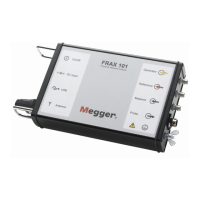2.11. Safety instructions
WARNING
1. It is not possible to eliminate all potential hazards from, and in using, electrical test equip-
ment. For this reason, every eort has been made to point out in this instruction manual the
proper procedures and precautions to be followed by the user in operating this equipment
and to mark the equipment itself with precautionary warnings where appropriate. It is
not possible to foresee every hazard which may occur in the various applications of this
equipment. It is therefore essential that the user, in addition to following the safety rules in
this manual, also carefully consider all safety aspects of the test before proceeding.
2. The test set and the specimen to which it is connected are a possible source of high-voltage
electrical energy and all persons making or assisting in tests must use all safety practice
precautions to prevent contact with energized parts of the test equipment and related
circuits.
3. Persons engaged in the test must stand clear of all parts of the complete high-voltage
circuit, including all connections, unless the test set is de-energized, and all parts of the test
circuit are grounded. Persons not directly involved with the work must be kept away from
test activities by suitable barriers, barricades, or warnings.
4. Treat all terminals of high-voltage power equipment as a potential electric shock hazard.
There is always the potential of voltages being induced at these terminals because of prox-
imity to energized high-voltage lines or equipment.
5. Always ground connection points of the test specimen before connecting any leads from
the test set. Whenever possible, always keep one side of the test specimen grounded at all
times. Always use a safety ground stick to ground any high-voltage conductor.
6. The ground connection on the test set must be the rst made and the last removed. Any
interruption of the grounding connection can create an electric shock hazard.
7. Make sure that the instrument is properly grounded, both through its AC power cord and
through the ground connector. The AC power cord is the disconnecting device.
8. Always disconnect test leads from test specimen before attempting to disconnect them at
the test set.
9. High-voltage discharges and other sources of strong electric or magnetic elds may interfere
with the proper functioning of heart pacemakers. Persons with heart pacemakers should
obtain expert advice on the possible risks before operating this equipment or being close to
the equipment during operation.
10. All persons making or assisting in tests must use all practical safety precautions to prevent
contact with energized parts of the test equipment and related circuits. Also follow all local
and company safety requirements.
11. Safety is the responsibility of the user.
12. Misuse of this high-voltage equipment can be extremely dangerous.
13. The purpose of this equipment is limited to use as described in this manual. Do not use the
equipment or its accessories with any device other than specically described.
14. Before making any connections, make sure that the instrument is de-energized and that all
parts of the test circuit are properly grounded.
15. Never connect more than one output at the time. All outputs are energized by the same
amplier and therefore all outputs are energized simultaneously.
16. Operation is prohibited in rain or snow.
17. Do not use the test set in an explosive atmosphere.
18. Refer all servicing to qualied personnel.
19. A qualied operator should attend all times while the test equipment is in operation.
20. Observe all safety warnings marked on the equipment.
21. Corrective maintenance must only be performed by qualied personnel who are familiar
with the design and operation of the test set and the hazards involved.
Maintenance
General safety
www.megger.com FRAX-series 11

